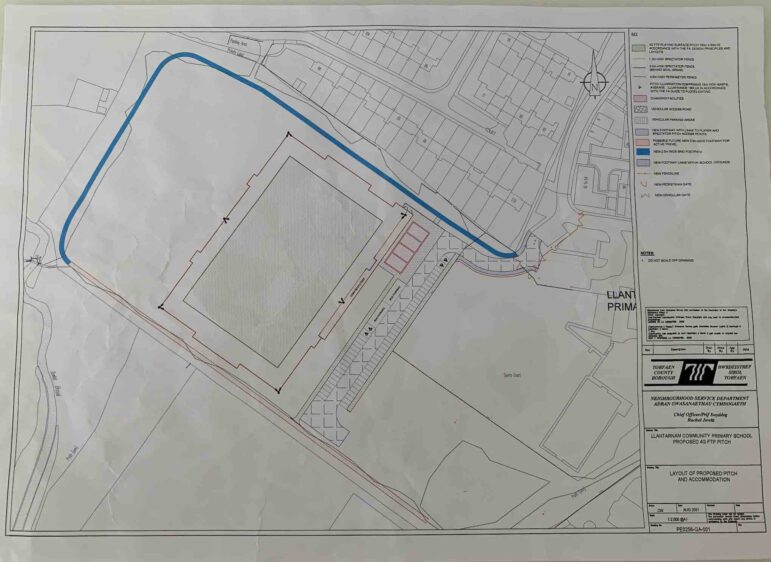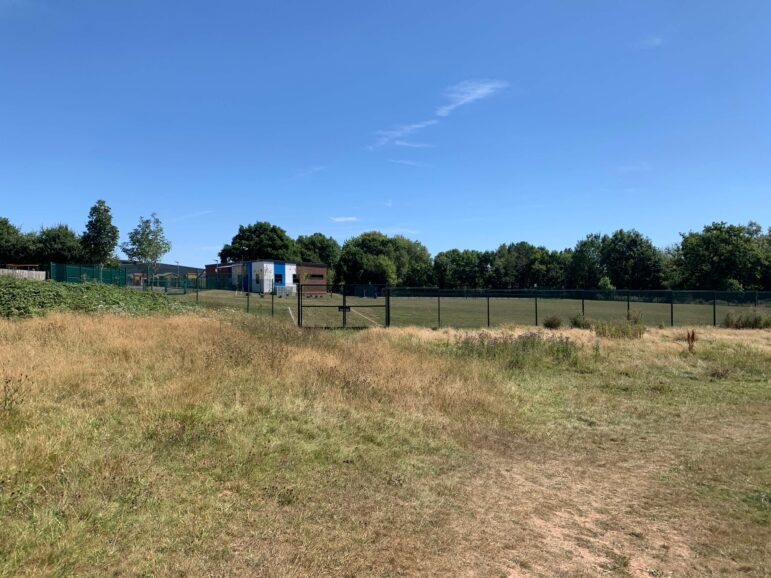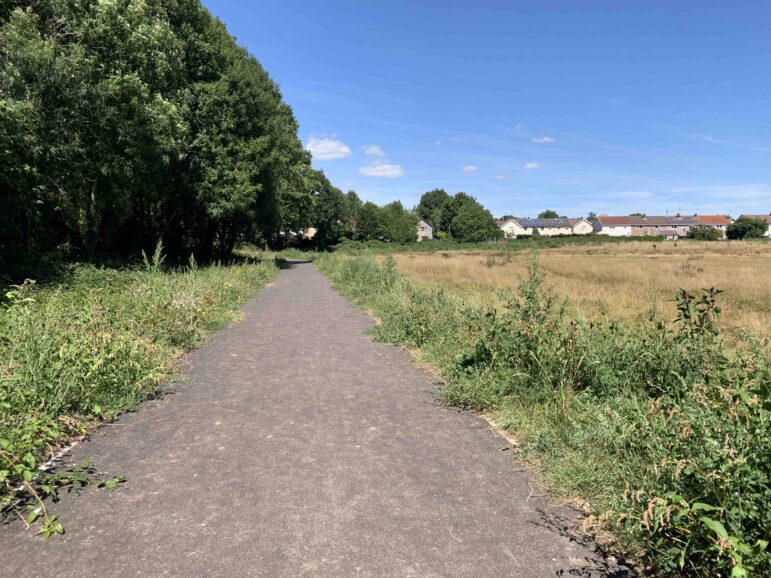In May 2015 planning permission was given for Llantarnam Comprehensive School to be demolished and 226 homes to be built on the site. In the same year Llantarnam leisure centre closed when Llantarnam and Fairwater schools merged to form Cwmbran High School (on the site of Fairwater Comprehensive School).
The decision to approve the development- now known as James Prosser Way– included an S106 agreement which is a “legally binding” contract about something that councils say must be done to negate any loss to the community from a development. The 2015 application said that Barratt Homes should pay £859,094 to replace the loss of three playing pitches and the leisure centre with a 3G/ 4G facility.
The new Llantarnam Community Primary School opened on part of site in 2016 and the homes were built in 2017. Two of the comprehensive school’s former sports pitches were left untouched and identified as a site for the replacement facilities. The council has received the money from Barratt Homes but delays to the project have seen the grass grow wild- leading to some opposition to it now being used for new sports facilities. One opponent wants it to be “declared as a local nature reserve.”
In 2015 the council’s recreation officer said that the S106 would allow “two 3G pitches” to be built. But a rise in costs over the years means the latest draft drawing of the site only shows one pitch. Any plans for the site would have to go through the council’s planning process for a decision.

A Torfaen Council spokesperson said: “The Council continues to explore the best options for the site and particularly a 3G sports pitch to replace the loss of the school playing fields. The Council recognises that this project has been delayed. However, costs have risen significantly since the school site was redeveloped and funding options are currently being revisited which we recognise is delaying the project.”

For a new pitch
Councillor Alan Slade, Llantarnam Ward, said: “This area has been a sports field since the days of the comprehensive school and the 3G pitch was promised to the community within the planning application for James Prosser Way as compensation for the loss of playing fields. The current situation is entirely due to the Council not constructing the 3G pitch in a timely manner and failing to maintain the field since the first lockdown.”
Against a new pitch
Phil Davies, an Oakfield resident who stood for the Green Party in the Llantarnam Ward in May’s local government elections, said: “The destruction of this site would show the council do not care about nature despite declaring a nature emergency in 2019. It also shows they don’t care about local peoples opinions as hundreds of people have already expressed that they do not want this vital site of biodiversity to be destroyed. We never got to vote on this. It is already used and enjoyed by hundreds of people from all ages. It also shows they don’t care about the water system this site is right by Dowlais Brook this would pollute it with micro-plastics and awful chemicals that are needed to stop algae and moss growing on the artificial pitches surface. It goes against the 2015 Well being of Future Generations (Wales) act that all decisions the council makes are supposed to be guided by and the recent United Nations resolution declaring a healthy environment a human right. As a public open space it should be up to the people what is done with the site not the councillors.
“So much of Llantarnam’s key grassland habitat has already been destroyed for house building over that past decade or more and this is now a key carbon sink for the ward. If the council cares about both nature and democracy it will allow an independent ecological survey to take place before any further grass cutting or work takes place. We already know this is supporting at risk species. It will also allow the people to express how much mental and physical well-being this site brings them and how it should be declared as a local nature reserve that can be used by the local primary school amongst others to teach children about the importance of healthy ecosystems and biodiversity.”

Background from the 2015 planning application about the S106 agreement
Page 23 of the report: “The loss of the area of 3 playing pitches and facilities associated with these at the leisure centre and the development’s own requirement means that significant adult recreation (of equal community benefit, value and quality) needs to be provided in the surrounding area. The estimated cost of this is significant at £859,094. An opportunity exists in the locality to improve the western playing field area but this area is partially affected by flooding and no details have been provided as to how this or another area is to be reorganised in order to provide improved recreation facilities. For the residential development to be considered for approval I would request that a detailed scheme showing the replacement recreation provision (Potentially incorporating a significant 3G or 4G floodlit facility – details of what is required/needed can be provided/designed by recreation) be provided. This facility could be financed through the s106 requirement for recreation detailed above.”
Page 34 of the report: “The Open Space Study carried out in relation to the Torfaen Local Plan, has identified a shortfall of recreation space in the area. Therefore the loss of the playing fields needs to be mitigated. Fields in Trust and Sport Wales have stated that they would object to the loss of the playing fields should alternative provision to mitigate the loss of the playing fields not be provided and should adequate facilities not be provided for the future residents of the proposed development. The applicant has agreed in principle to pay a commuted sum to mitigate the loss of the playing field and to make satisfactory compensatory provision of equal community benefit, value and quality, in accordance with Policy CF5 and PPW. This commuted sum would be secured through a section 106 agreement. It has been calculated, using the method in the SPG, that to provide satisfactory compensatory provision for the loss of the three pitches, it would cost a total of £602,358. In consultation with the Council’s recreation and education department, it is proposed to use this contribution to fund the provision of 2No. 3G pitches on the remaining playing fields to the west of the new school.
“The Council’s recreation officer has confirmed that this would significantly improve and increase the recreation facilities in the area for the general public which would provide satisfactory compensatory provision for the loss of the pitches. In addition to this there is also a requirement for a contribution for adult recreation facilities to address the demand raised by this development. In accordance with the Council’s Planning Obligations, there is a requirement for a payment of £1136 per dwelling. This would total £256,736. The Council’s Recreation Officer has stated that this contribution could be used to provide additional improvements to the scheme for the two 3G pitches or equivalent to be set out in the Section 106 Agreement. Fields in Trust and Sport Wales have confirmed that they are satisfied that the proposed mitigation provide adequate compensatory provision. It is therefore considered that adequate mitigation can be provided for the loss of the school playing field, subject to further details being agreed as part of the Section 106 Agreement and therefore policy CFS and PPW can be complied with.
What is an S106 agreement?
The Senedd published a guide to Section 106 agreements in 2015. It says that:
“A Section 106 agreement (S106) is a legally binding private contract between a developer (or a number of interested parties) and a Local Planning Authority (LPA) that operates alongside a statutory planning permission. Such agreements require developers to carry out specified planning obligations when implementing planning permissions and are the result of negotiations on these matters between the parties. An agreement may be entered into to prescribe the nature of development, to secure a contribution from a developer to compensate for any loss or damage caused by a development, or to mitigate a development’s wider impact”

